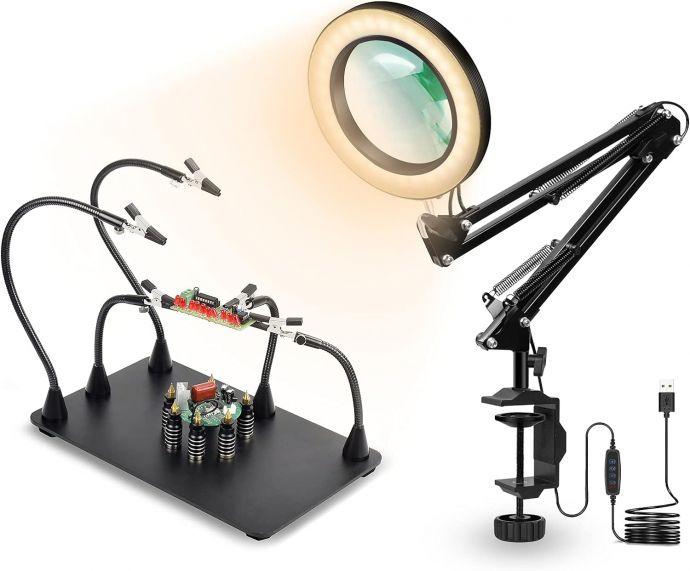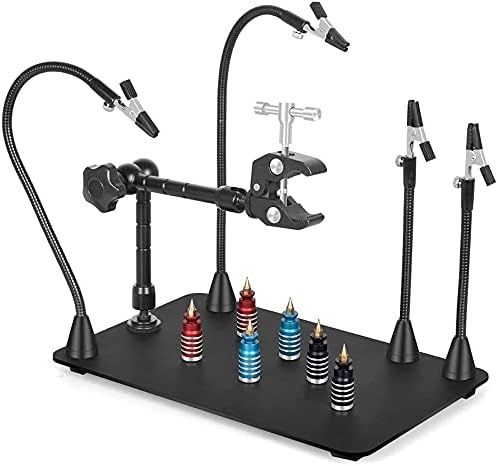In the world of electronics, soldering is an essential skill, and for many, it’s more than a necessary task—it's a passion. However, the joy of crafting circuits can be overshadowed by the voluminous fumes that soldering produces, which can pose health risks. Enter the DIY solution: a 6.7 fan-powered solder fume extractor designed to absorb, remove, and prevent smoke, offering a healthier soldering station experience.
### Understanding the Need for a Solder Fume Extractor

Soldering involves melting solder to join two metal surfaces. This process releases smoke that contains potentially harmful fumes, including lead, a variety of flux vapors, and other metallic particulates. Prolonged exposure to these fumes can lead to respiratory issues and other health problems. Therefore, it's crucial to implement a mechanism to mitigate this exposure, especially in a home DIY setting where professional ventilation systems are typically absent.
### The DIY Journey: Building the Ultimate Fume Extractor
A 6.7 fan-powered solder fume extractor combines efficiency with cost-effectiveness, making it an ideal project for electronics enthusiasts looking to enhance their workspace safety. This DIY guide will walk you through the process of crafting your very own extractor.

#### Materials Needed:
- **6.7-inch Axial Fan**: The powerhouse of your extractor, capable of moving a significant volume of air.
- **Activated Carbon Filters**: These filters are essential for trapping harmful particles and gases.
- **Fan Housing**: A durable plastic or metal casing to encase the fan and filter.
- **Power Supply**: Suitable for your fan, usually a 12V adapter.

- **On/Off Switch**: For user convenience.
- **Flexible Duct Hose** (optional): To direct extracted fumes to an exhaust point.
- **Basic Tools**: Screwdriver, wire cutters, soldering iron, etc.
#### Building Steps:

**1. Preparing the Fan:**
Start by selecting a quality 6.7-inch axial fan. Look for one with a high cubic feet per minute (CFM) rating to ensure efficient air movement. Typically, a CFM of 120 or higher is suitable for small to medium-sized soldering stations.
**2. Constructing the Housing:**
The housing should snugly fit the fan and allow for easy installation of the activated carbon filters. You can either source a pre-made case or repurpose materials like PVC pipes or acrylic sheets. Ensure the design allows easy access for filter replacement.

**3. Installing the Filters:**
Position the activated carbon filters directly behind or in front of the fan within the housing. These filters are crucial as they absorb the harmful components of the solder fumes. Multiple layers can be added for improved filtration efficiency.
**4. Wiring the System:**
Connect the fan to its power source. It’s advisable to include an on/off switch in the circuit for easier control over the device. Solder connections should be insulated properly to avoid short circuits.

**5. Optional: Adding a Duct Hose:**
For those looking to enhance their system, attaching a flexible duct hose can help direct the filtered air outside or into a secondary filtering system, further cleaning the air in your workspace.
### Operational Tips
Once assembled, place the fume extractor as close as possible to the source of the smoke—usually directly behind the soldering iron—and ensure it's positioned to capture the rising fumes. Regularly check and replace filters as needed, depending on your soldering frequency. A fresh, unclogged filter will maintain the efficiency of the extractor.

### Enhancing the Solder Station Experience
The DIY fume extractor not only contributes to a healthier work environment but also boosts productivity by clearing the immediate workspace of visual obstructions caused by smoke clouds. Furthermore, the process of constructing such a useful device can be immensely satisfying for those who enjoy problem-solving and building.
#### Maintenance and Troubleshooting
Regular maintenance is key to ensuring the longevity and effectiveness of your fume extractor. Here's a quick guide to keep it in optimal condition:
- **Filter Maintenance**: Check filters monthly, depending on usage. Replace when they become discolored or saturated with particulates.
- **Fan Check**: Ensure the fan blades are free of dust and debris. Clean as necessary with a soft cloth to maintain airflow.
- **Electrical Safety**: Periodically inspect electrical connections and insulate any exposed wires.
In case of reduced airflow, check for blockages or filter saturation. If the fan fails to operate, verify the power supply and switch functionality.
### Health Benefits
Beyond clearing the air, using a fume extractor significantly reduces the risk of respiratory ailments associated with solder fumes. Activated carbon is particularly effective at adsorbing the volatile organic compounds present in solder smoke, safeguarding not just your lungs but your overall health.
### Conclusion
Building your own 6.7 fan-powered solder fume extractor is not merely a project; it's an investment in health and safety amid the rewarding realm of electronics. This device embodies the spirit of DIY ingenuity—an affordable, efficient solution tailored to individual needs. As you navigate through this endeavor, remember that maintaining a safe environment is crucial, enabling you to focus on the intricate details of your soldering projects with peace of mind.









